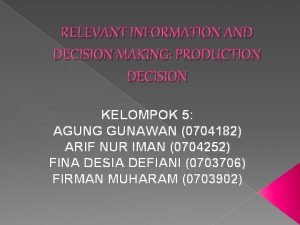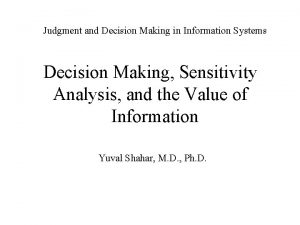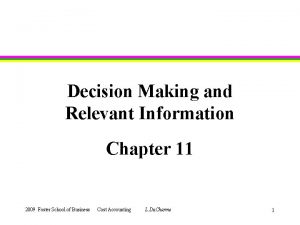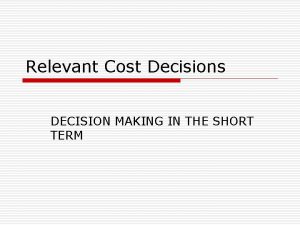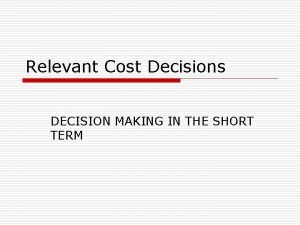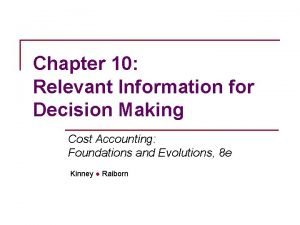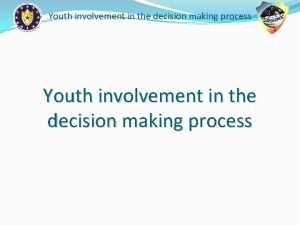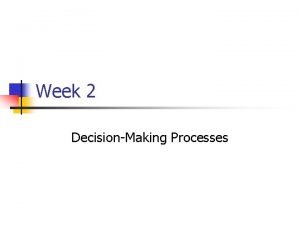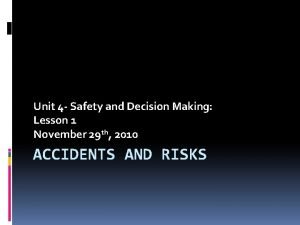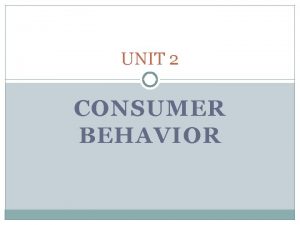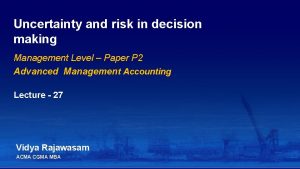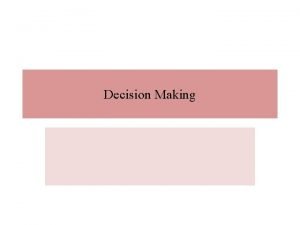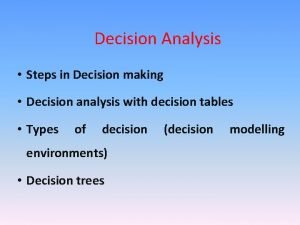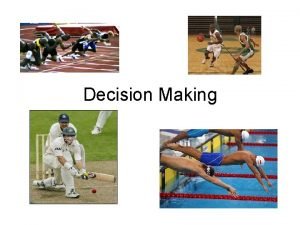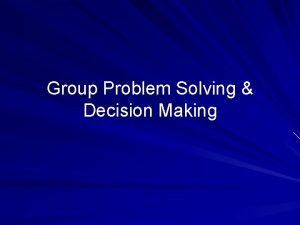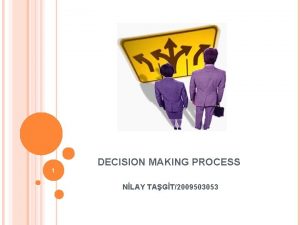Information System as an Aid to Decision Making



























- Slides: 27

Information System as an Aid to Decision Making Md. Rashedul Hasan Southern University Bangladesh.

Changes in the Business Environment: Drivers of Change Information Technology has been developed that has made information preparation and dissemination inexpensive. This technology has taken the form of low cost, high-speed digital and cable video and data transmission, hardware that produces information quickly and easily, and the development of software that makes preparation, data, and communication tools available to individuals who previously did not have access to needed information. With these technology developments, time, space, and other temporal constraints to information have been reduced and, in many cases, eliminated

Globalization A second major development that has significantly impacted business has been globalization. Faster methods of transportation, together with instantaneous information, have allowed the world to become one giant marketplace. Consumers can now buy products from foreign firms as easily as they can from a local store. Organizations such as General Motors have to worry not only about what Chrysler and Ford are doing, but also what Toyota, Volkswagen, and BMW are doing as well. In fact, Chrysler is not just “Chrysler” anymore. It is now a conglomeration of European, North American, and Asian manufacturers known as Daimler. Chrysler. Instead of having only two major American competitors, General Motors and all other business organizations now have to compete with similar companies throughout the world. In addition, with the increased availability of inexpensive information, more is known about these competitors and about General Motors than ever before. If a General Motors product has deficiencies, for example, the world knows about and can act on those problems instantly.

Concentration A third major change is the concentration of power in certain market investors, primarily large mutual and pension funds. Mutual funds such as Fidelity and Vanguard, and pensions funds such as CALPERS, for example, now hold major stock positions in many companies. The influence of these major market players is so significant that, if they are displeased, corporate executives will find that their positions within the company are in jeopardy. Armed with easily available and inexpensive information about investees and their competitors, large institutional investors raise the competitive bar very high and shorten the periods over which success is measured.

Results of These Change Drivers • First, they have eliminated the old model that assumed information is expensive. Today anyone, armed with the right software, can be an “accountant” and produce financial information. • Second, they have dramatically increased the level of competition among organizations. Historically successful business models become obsolete. Since information about all organizations is widely available, only organizations that are truly the best survive and remain successful.

Business developments because of these changes • • • An increased pace of change in the business world Shorter product life cycles and shorter competitive advantages A requirement for better, quicker, and more decisive actions by management Emergence of new companies and new industries Emergence of new professional services Outsourcing of non-value-added, but necessary, services Increased uncertainty and the explicit recognition of risk Increasingly complex business transactions Changes in financial reporting and relationships with financial markets and major market players Increased regulatory activity Increased focus on customer satisfaction

Data versus Information • Data refers to raw, unevaluated facts, figures, symbols, objects, events, etc. Data may be a collection of facts lying in storage, like a telephone directory or census records. • Information is data that have been put into a meaningful and useful context and communicated to a recipient who uses it to make decisions. Information involves the communication and reception of intelligence or knowledge.

Characteristics of Information The characteristics of good information are relevance, timeliness, accuracy, costeffectiveness, reliability, usability, exhaustiveness, and aggregation level. • Information is relevant if it leads to improved decision making. It might also be relevant if it reaffirms a previous decision. If it does not have anything to do with your problem, it is irrelevant. For example, information about the weather conditions in Paris in January is relevant if you are considering a visit to Paris in January. Otherwise, the information is not relevant. • Timeliness refers to the currency of the information presented to the users. Currency of data or information is the time gap between the occurrences of an event in the field until its presentation to the user (decision maker). When this amount of time is very short, we describe the information system as a realtime system. • Accuracy is measured by comparing the data to actual events. The importance of accurate data varies with the type of decisions that need to be made. Payroll information must be exact. Approximations simply will not suffice. However, a general estimate of how much staff time was devoted to a particular activity may be all that is needed.

Value of Information has a great impact on decision making, and hence its value is closely tied to the decisions that result from its use. Information does not have an absolute universal value. Its value is related to those who use it, when it is used, and in what situation it is used. In this sense, information is similar to other commodities. For example, the value of a glass of water is different for someone who has lost his way in Arctic glaciers than it is to a wanderer in the Sahara Desert. Information supports decisions, decisions trigger actions, and actions affect the achievements or performance of the organization.

Information as an Aid to Decision Making Simon (1977) describes the process of decision making as comprising four steps: intelligence, design, choice, and review.

• The intelligence stage encompasses collection, classification, processing, and presentation of data relating to the organization and its environment. This is necessary to identify situations calling for decision. • During the decision stage, the decision maker outlines alternative solutions, each of which involves a set of actions to be taken. The data gathered during the intelligence stage are now used by statistical and other models to forecast possible outcomes for each alternative. Each alternative can also be examined for technological, behavioral, and economic feasibility. • In the choice stage, the decision maker must select one of the alternatives that will best contribute to the goals of the organization. • Past choices can be subjected to review during implementation and monitoring to enable the manager to learn from mistakes. Information plays an important role in all four stages of the decision process.

Decision-Making Levels

Senior Management • Makes decisions based on internal business information but also external industry and society changes; decisions affect long-term and strategic goals and the firm's objectives. • Top-level managers, or top managers, are also called senior management or executives. These individuals are at the top one or two levels in an organization, and hold titles such as: Chief Executive Officer (CEO), Chief Financial Officer (CFO), Chief Operational Officer (COO), Chief Information Officer (CIO), Chairperson of the Board, President, Vice president, Corporate head. • Often, a set of these managers will constitute the top management team, which is composed of the CEO, the COO, and other department heads. Top-level managers make decisions affecting the entirety of the firm. Top managers do not direct the day-to-day activities of the firm; rather, they set goals for the organization and direct the company to achieve them. Top managers are ultimately responsible for the performance of the organization, and often, these managers have very visible jobs.

Middle Management and project teams: • Decisions affect resource allocation, short-range plans and performance of specific departments, task forces, teams, and special project groups. • Middle-level managers, or middle managers, are those in the levels below top managers. Middle managers' job titles include: General Manager, Plant manager, Regional manager, and Divisional manager. • Middle-level managers are responsible for carrying out the goals set by top management. They do so by setting goals for their departments and other business units. Middle managers can motivate and assist first-line managers to achieve business objectives. Middle managers may also communicate upward, by offering suggestions and feedback to top managers. Because middle managers are more involved in the day-to-day workings of a company, they may provide valuable information to top managers to help improve the organization's bottom line.

First-level managers and project teams: • Decisions affect subunits and individual employees regarding the resources, schedules and personnel decisions for specific projects. • First-level managers are also called first-line managers or supervisors. These managers have job titles such as: Office manager, Shift supervisor, Department manager, Foreperson, Crew leader, Store manager. • First-line managers are responsible for the daily management of line workers—the employees who actually produce the product or offer the service. There are first-line managers in every work unit in the organization. Although first-level managers typically do not set goals for the organization, they have a very strong influence on the company. These are the managers that most employees interact with on a daily basis, and if the managers perform poorly, employees may also perform poorly, may lack motivation, or may leave the company.

Types of Decisions Unstructured: requires judgment, evaluation, and insight into non-routine situations. Usually made at senior levels of management. Structured: repetitive, routine, with definite procedures for making the decision. Usually made at the lowest organizational levels. Semi structured: A combination of the two. Usually made by middle managers.

The level of Management people, their information needs & Decision characteristics

Summary

The Four Major Types of Information Systems

Organizational Level & System for decision support

Major Types of Systems: Transaction Processing Systems Computerized system that performs and records the daily routine transaction necessary to conduct the business. They serve the organization’s operational level. Transaction Processing Systems ("TPS") are designed to process routine transactions efficiently and accurately. TPSs collect, store, modify, and retrieve the transactions of an organization. A business will have several (sometimes many) TPS; for example: • - Payroll TPS. • - Billing systems to send invoices to customers - Systems to calculate the weekly and monthly payroll and tax payments - Production and purchasing systems to calculate raw material requirements - Stock control systems to process all movements into, within and out of the business

Management Information Systems • A management information system ("MIS") is mainly concerned with internal sources of information. MIS usually take data from the transaction processing systems and summarize it into a series of management reports. • It is actually information system at the management level of an Organization that serves the function of Planning, Controlling and Decision making by providing routine summary and exception reports. MIS summarizes and report on the company’s basic operation. The basic transaction data from TPS are usually transformed into MIS report. MIS usually serve the managers interested in weekly, monthly and yearly results- not day-to-day activities. MIS generally provide answer to routine questions that have been specified in advance and have a predefined procedure for answering them.

Decision-Support Systems Information System at the organization’s management level that combine data and sophisticated analytical models or data analysis tools to support semi-structured and unstructured decision making. DSS helps managers make decision that are unique, rapidly changing and not easily specified in advance. Although DSS use information from TPS and MIS, they often bring in information from external source such as current stock prices or product price of information. DSS have more analytical power than other system. They are built with variety of models to analyze the data for decisionmaking. DSS often involves use of complex spreadsheet and databases to create "what-if" models.

Executive Support Systems Senior Managers uses the ESS to make decision-making. ESS serves the strategic level of the organization. They address nonroutine decisions requiring judgment, evaluation and insight because there is no predefined procedure for arriving at a solution. An Executive Support System ("ESS") is designed to help senior management make strategic decisions. It gathers, analyses and summarizes the key internal and external information used in the business. A good way to think about an ESS is to imagine the senior management team in an aircraft cockpit - with the instrument panel showing them the status of all the key business activities. ESS typically involves lots of data analysis and modeling tools such as "what-if" analysis to help strategic decision-making.

Relationship of Systems to One Another The key element for all these systems is integration. Figure shows how the various systems supply information to one another and combine to serve the best interests of the organization as a whole.

Integration of decision making process and system support

Thank You
 How do information systems aid in decision making
How do information systems aid in decision making No decision snap decision responsible decision
No decision snap decision responsible decision Slidetodoc.com
Slidetodoc.com Decision making and relevant information
Decision making and relevant information Chapter 11 decision making and relevant information
Chapter 11 decision making and relevant information Value of information in decision making
Value of information in decision making Relevant information for decision making
Relevant information for decision making Chapter 11 decision making and relevant information
Chapter 11 decision making and relevant information Decision making and relevant information
Decision making and relevant information 5 step decision making process
5 step decision making process Decision making and relevant information
Decision making and relevant information Relevant information for decision making
Relevant information for decision making First aid merit badge first aid kit
First aid merit badge first aid kit Greenhill park medical centre
Greenhill park medical centre International patient decision aid standards
International patient decision aid standards Decision table and decision tree examples
Decision table and decision tree examples Involvement decision making
Involvement decision making Reamer ethical decision making model
Reamer ethical decision making model Systematic decision making process
Systematic decision making process What doing our country
What doing our country Mamdm
Mamdm Using recursion in models and decision making sheet 3
Using recursion in models and decision making sheet 3 What is this image
What is this image Unit 4 lesson 1 decision making
Unit 4 lesson 1 decision making Decision making unit example
Decision making unit example Types of decision making
Types of decision making Higher business management
Higher business management Contribution payoff table
Contribution payoff table



